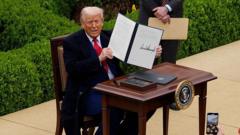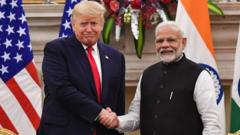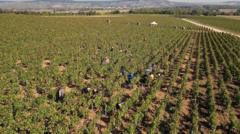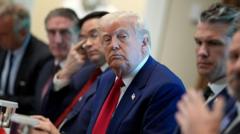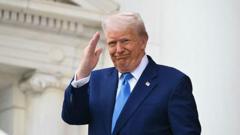Burgundy winemakers, heavily reliant on the U.S. market, are increasingly anxious due to Donald Trump's tariff policies, which could impose significant financial burdens and jeopardize sales.
Burgundy Winemakers Grapple with Trump's Tariff Turmoil

Burgundy Winemakers Grapple with Trump's Tariff Turmoil
The wine industry in Burgundy faces daunting challenges as Trump's tariffs threaten American market access for European wines, creating uncertainty for producers.
Article Text:
Burgundy, a revered wine region in eastern France, is home to some of the world's finest wines, yet winemakers are now facing the bitter aftertaste of Donald Trump's tariff policies. The United States constitutes Burgundy's most significant export market, but escalating tariffs create the risk of pricing European wines out of American consumers' reach.
Amidst a drizzling spring day, Élodie Bonet, a vineyard worker, meticulously prunes vine shoots, ensuring the grapevines concentrate their energy for an abundant yield. At her winery in the picturesque village of Morey-Saint-Denis, Cécile Tremblay offers a glimpse into the world of Burgundy’s wines, standing among age-old barrels and revered vintage bottles.
Under her label, Domaine Cecile Tremblay, she reports that nearly 10% of her production is aimed at the U.S. market. However, recent trade tensions have taken an unsettling turn; after initially proposing a staggering 200% increase on European alcohol, Trump instituted a 20% tariff on European Union products. This was later adjusted to 10%, with further increases looming depending on trade negotiations. For many, including Tremblay, the stakes couldn't be higher.
François Labet, president of the Burgundy Wine Board, emphasizes the critical role the U.S. plays in Burgundy's economy—accounting for approximately 25% of exports. In recent years, sales of Burgundy wines to the U.S. soared, contrasting sharply with the overall decline in the export market for French wines and spirits.
Historically, when Trump previously imposed a 25% import tariff, Burgundy experienced a staggering 50% drop in exports to the U.S., a haunting memory that weighs heavily on vintners now faced with uncertainty. Labet predicts that a potential increase to 20% could halt sales once more, leading the region back to a crisis similar to 2019, causing catastrophe to both winemakers and the broader market.
Jerome Bauer, representing the French National Wines and Spirits Confederation, echoes these concerns, recalling the rapid financial loss during Trump's earlier tariff regime. Meanwhile, many winemakers back a push for tariff-free trade despite the existing trade surplus Europe maintains with the U.S.
Interestingly, American winemakers in regions like Napa Valley join their French counterparts in decrying the tariffs, with Rex Stoltz, vice-president of Napa Valley Vintners, highlighting the adverse effects on their exports, particularly to Canada.
“We want a fair playing field for all wine producers globally,” Stoltz states, reflecting a shared hope among winemakers on both sides of the Atlantic as they navigate the murky waters created by trade conflicts and shifting tariffs.
Burgundy, a revered wine region in eastern France, is home to some of the world's finest wines, yet winemakers are now facing the bitter aftertaste of Donald Trump's tariff policies. The United States constitutes Burgundy's most significant export market, but escalating tariffs create the risk of pricing European wines out of American consumers' reach.
Amidst a drizzling spring day, Élodie Bonet, a vineyard worker, meticulously prunes vine shoots, ensuring the grapevines concentrate their energy for an abundant yield. At her winery in the picturesque village of Morey-Saint-Denis, Cécile Tremblay offers a glimpse into the world of Burgundy’s wines, standing among age-old barrels and revered vintage bottles.
Under her label, Domaine Cecile Tremblay, she reports that nearly 10% of her production is aimed at the U.S. market. However, recent trade tensions have taken an unsettling turn; after initially proposing a staggering 200% increase on European alcohol, Trump instituted a 20% tariff on European Union products. This was later adjusted to 10%, with further increases looming depending on trade negotiations. For many, including Tremblay, the stakes couldn't be higher.
François Labet, president of the Burgundy Wine Board, emphasizes the critical role the U.S. plays in Burgundy's economy—accounting for approximately 25% of exports. In recent years, sales of Burgundy wines to the U.S. soared, contrasting sharply with the overall decline in the export market for French wines and spirits.
Historically, when Trump previously imposed a 25% import tariff, Burgundy experienced a staggering 50% drop in exports to the U.S., a haunting memory that weighs heavily on vintners now faced with uncertainty. Labet predicts that a potential increase to 20% could halt sales once more, leading the region back to a crisis similar to 2019, causing catastrophe to both winemakers and the broader market.
Jerome Bauer, representing the French National Wines and Spirits Confederation, echoes these concerns, recalling the rapid financial loss during Trump's earlier tariff regime. Meanwhile, many winemakers back a push for tariff-free trade despite the existing trade surplus Europe maintains with the U.S.
Interestingly, American winemakers in regions like Napa Valley join their French counterparts in decrying the tariffs, with Rex Stoltz, vice-president of Napa Valley Vintners, highlighting the adverse effects on their exports, particularly to Canada.
“We want a fair playing field for all wine producers globally,” Stoltz states, reflecting a shared hope among winemakers on both sides of the Atlantic as they navigate the murky waters created by trade conflicts and shifting tariffs.




